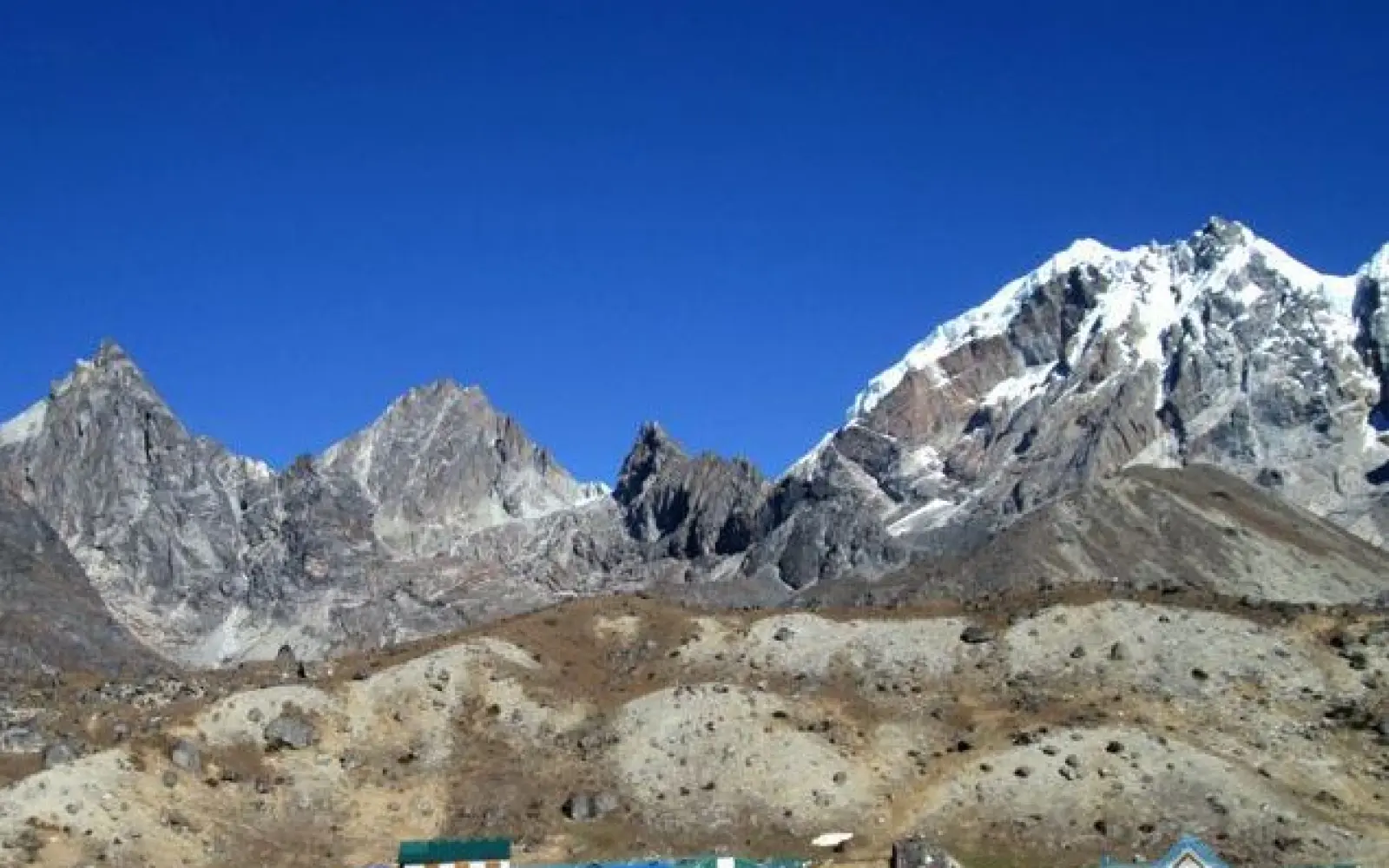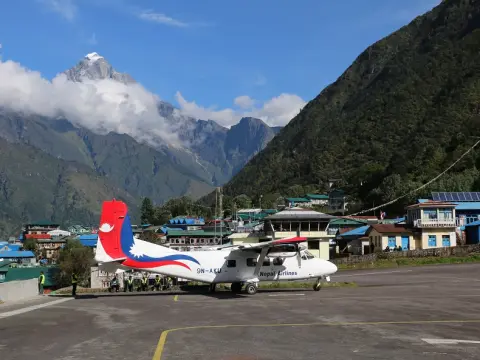Kalapatthar: The Best Viewpoint to See Everest
Introduction:Kalapathar is a giant rocky summit in Nepal's Everest region. It stands at an altitude of 5,545 meters or 18,192 feet. This makes it one...


Dzongla is a small mountain village in the Everest region of Nepal. It is located at an elevation of approximately 4,830 meters (15,846 feet). The village is an important stopover for trekkers trekking towards higher elevations like Dingboche, Lobuche, or Everest Base Camp. Due to its high elevation, acclimatization is a very popular reason to stop over in Dzongla.
Meanwhile, the Dzongla village is surrounded by charming snow-capped peaks and hilly landscapes. These natural surroundings provide a peaceful and serene atmosphere. Dzongla is surrounded by stunning Himalayan vistas, including Ama Dablam (6,812m) and Thamserku (6,623m). This renders the village perfect for shooting and relaxation.
Further, Dzongla boasts a small number of tea houses and lodges. They provide simple facilities and food for trekkers. There are limited facilities in the village, but the local people's generosity overcomes this shortage. Trekkers relish the serene and cozy environment.
Similarly, Dzongla is only reachable on foot. The journey from Namche Bazaar or Pheriche is along rhododendron forests and alpine slopes to Dzongla. The trek is full of beautiful vistas of mountains, valleys, and rivers. The journey might be challenging with altitude and weather.
Because Dzongla is a high-altitude area, the weather conditions can change quickly. Snowfall is not out of the ordinary during winter months, and temperatures fall below freezing. Therefore, trekkers tend to halt at this point to acclimatize before going any further.
In short, Dzongla is a point of call for every Everest trekker. It offers breathtaking scenery, calm environment, and acclimatization. The village is the most favored among those who are preparing for steeper ascents.
Dzongla lies in the Solukhumbu district in Nepal. It lies in the Everest region, which is famous worldwide for trekking and climbing. The village stands at an elevation of around 4,830 meters (15,846 feet). This makes Dzongla above the tree line, in an alpine zone.
Meanwhile, the landscape around Dzongla is mountainous and rough. The village exists on a small plateau encircled by huge peaks and steep mountains. To the southwest, there is Ama Dablam (6,812m) and to the east is Thamserku (6,623m). The peaks are huge and fill the skyline, forming a breathtaking landscape around them.
Moreover, the landscape around Dzongla is rocky outcrops and sparse vegetation due to its high altitude. Alpine grasses, mosses, and robust shrubs are the vegetation that can be seen growing here. Snow covers the landscape most of the year, especially winter and early spring.
Likewise, Dzongla lies along a popular trek route from Namche Bazaar to Lobuche. The route traverses ridges and valleys, crossing tiny streams and passes. The route offers stunning scenery of the Himalayas and rugged glacier-sculptured valleys. Trekkers experience varying environments from lower elevations rhododendron forests to exposed rock slopes near Dzongla.
Due to its height, Dzongla is cold throughout the year. In winter, it gets heavy snow, while in summer, it gets cool and dry weather. Weather can change instantly, with frequent stormy winds at times. Trekkers should therefore be prepared to encounter bad weather.
In a nutshell, Dzongla's location and geography are the reasons why it is such a unique mountain village. Its alpine landscape, between Himalayan giants, offers breathtaking views. This is exactly why Dzongla is such a required layover for trekkers testing the Everest region.

Dzongla is only reachable by trekking. There are no roads and no motor transport to the high mountain village. Trekkers usually reach Dzongla on the busy Everest Base Camp trail. The trek usually begins from Lukla, where there is the closest airport. From Lukla, trekkers trek to Namche Bazaar and other villages to reach Dzongla.
Actually, the four- or five-day journey from Namche Bazaar to Dzongla is along a trail that goes through Tengboche, Dingboche, and other villages. The trail is well marked but occasionally steep and rocky. Also, the altitude rises gradually, and there has to be enough time for acclimatization.
Moreover, Dzongla is approximately a day's walk northeast from Dingboche. The route traverses rugged ridges and goes through stunning alpine meadows. Hikers have amazing vistas of mountains such as Ama Dablam (6,812 m) and Lhotse (8,516 m) on this section of the trek. This route is weather exposed, and hence wind and cold can be harsh.
Because Dzongla is situated at 4,830 meters, accessibility is affected by the weather. In winter and early spring, heavy snow may block trails. Trekking seasons in spring and autumn are therefore most popular. These times offer clearer weather and safer trail conditions.
In fact, there is no public transportation to Dzongla. Porters or trekkers must carry everything and all supplies. Yaks or mules help with the heavy loads. The communication is poor, and most of the electricity is solar power. Medical facilities are limited and only available in larger villages below.
To sum up, Dzongla is accessible only by foot on a well-tread trekking trail. The trek requires strong fitness, adequate acclimatization, and preparation. Remote as the route may be, the route is desired due to scenery that was breathtaking and a top trekking culture.
Accommodations in Dzongla are simple but adequate for trekkers. The village offers a number of tea houses and lodges that have simple rooms. Twin beds and foam mattresses are available in most rooms, and guests are provided with thick blankets to keep them warm. Heating is minimal because of the high altitude and cold weather, but some of the lodges have wood-burning stoves.
Meanwhile, the lodges at Dzongla have common cold water bathrooms as an average in Dzongla. There are also a few lodges with hot showers from solar heaters or gas heaters. The hot showers are especially an appreciated luxury after strenuous trekking days. Electricity is limited and mostly based on solar panels. Therefore, supply of power can be weather-dependent and not reliable.
Moreover, there are Nepalese foods like dal bhat, noodles, and momos available at the lodges in Dzongla. Sandwitch as well as pasta are served. Tea, coffee, and soup as hot beverages keep the trekkers warm. The tea houses provide cozy dining rooms where the trekkers get together and unwind.
Likewise, Dzongla possesses a few small shops selling trekking gear, snack foods, and general medicines. Porters and guides can usually plan their services here. There is a small medical post as well that offers basic first aid and general recommendations. Serious medical cases, however, must be evacuated to larger towns like Namche Bazaar or Kathmandu.
Furthermore, communication is weak with spotty mobile and internet coverage. Wi-Fi exists at a few lodges, though its speed is slow. Recharging battery gear may incur a minor fee.
Despite basic facilities, Dzongla's warm welcomes make visitors feel at ease. Warm hospitality and good meals result from local owners and staff. The peaceful mountain surroundings add to the convenience.
In short, Dzongla offers limited but essential facilities to high-altitude trekkers. The facilities enable trekkers to take a break, have healthy food, and plan the next part of their trek. Basic as they are, the facilities here are crucial to the safety and enjoyment of the trek.

Dzongla provides a number of significant attractions for visitors and trekkers. One is that its elevation at 4,830 meters makes it a significant acclimatization point along the Everest Base Camp trek. This altitude provides trekkers with time to acclimatize to thinner air before trekking further higher. Thus, most hikers stop over here to avoid altitude sickness.
Secondly, Dzongla is surrounded by breathtaking scenery of mountains. Trekkers get treated with the close-up sight of Ama Dablam, which stands 6,812 meters tall. This peak that is ideal for photography is one of the best photographed mountains of Nepal. Other mountains in the surroundings are Thamserku (6,623 meters) and Kangtega (6,782 meters). The panorama offers stunning views during sunrise and sunset.
Besides, the Dzongla village is located in a tranquil alpine environment. Unlike crowded lower villages, Dzongla provides a tranquil environment. The calm environment allows trekkers to relax and enjoy nature. Alpine meadows bloom with wildflowers during warm weather, providing shades of color to the environment.
Another attraction at Dzongla is the cultural exposure. Sherpa residents who live in traditional houses occupy Dzongla. Visitors are able to observe local tradition and hospitality. Prayer flags and miniature chortens are present within the village as well, which adds religious significance.
Likewise, the trekking trail to Dzongla itself is a draw. It twists and turns through gorgeous rhododendron woodlands and rugged terrain. Trekkers observe glaciers and frozen gouged valleys en route. The trek consists of elements of adventure and nature.
To sum up, the prime attractions of Dzongla are acclimatization, breathtaking mountain views, serene atmosphere, cultural diversity, and scenic trekking trails. These features make Dzongla an unforgettable location on the Everest trekking trail.
Dzongla offers several activities to trekkers and nature lovers alike. First of all, the principal activity is acclimatization. Due to its 4,830-meter elevation, the majority of trekkers overnight here so that their bodies can acclimatize. This helps prevent altitude sickness on higher parts of the Everest trek.
Also, trekking and hiking in Dzongla is a popular activity. Trekkers go to adjacent trails to enjoy stunning mountain vistas. A day hike to ridges and viewpoints provides wide Himalayan views. These day hikes provide a view of Ama Dablam (6,812 m), Thamserku (6,623 m), and other peaks.
Moreover, wildlife sighting is yet another pleasure at Dzongla. The region around Dzongla is home to Himalayan birds and small mammals. Trekkers can see snow pigeons, Himalayan marmots, and mountain goats. Watching this wildlife introduces thrill and bonding with nature.
Likewise, cultural interactions also attract visitors here in Dzongla. Sherpa villages are found at Dzongla. The Sherpas' customs, homes, and floating prayer flags are visible to trekkers. Sometimes, tourists attend local festivals or ceremonies, further enhancing the experience.
Similarly, relaxation is also imperative here in Dzongla. At the end of long days of hiking, Dzongla's tranquil environment offers rest and relaxation. Tea houses offer hot meals and warm places to relax. Trekkers socialize, share experiences, and prepare for the next part of the journey.
Last but not least, photography is also a favorite activity to do in Dzongla. The village and its neighboring peaks offer tremendous photo opportunities. Sunrise and sunset illuminate breathtaking scenery. Trekkers snap pictures as mementos to treasure forever.
Finally, the major activities in Dzongla are acclimatization, b, wildlife watching, cultural tour, relaxation, and photography. The activities are reciprocally complementary to make Dzongla a worthwhile stopover on the Everest trek.
Dzongla is so popular for a variety of important reasons. In the first place, it is 4,830 meters high and, therefore, is a critical acclimatization point on the Everest Base Camp trek. Consequently, the majority of walkers rest here in order to acclimatize their systems prior to ascending further. This minimizes the possibility of altitude sickness.
Moreover, Dzongla is known for its beautiful mountain views. Climbers from the village can see renowned peaks such as Ama Dablam (6,812 meters) ad Thamserku (6,623 meters). The mighty mountains are a photographer's and nature lover's paradise. Scenic beauty here can not be overlooked.
In addition to, Dzongla offers a peaceful and serene atmosphere. Unlike crowded lower villages, Dzongla is tranquil and silent. The peaceful atmosphere helps to overcome tension and recharge energy for the trekkers. Free mountain air and peaceful surroundings are savored by many.
Likewise, the Dzongla village's cultural attractiveness also contributes to its popularity. Dzongla contains Sherpa settlements that greet visitors warmly. Trekkers are subjected to local culture, hospitality, and Buddhist religious symbols like prayer flags and chortens. Such cultural richness adds depth to the trekking experience.
Secondly, the fact that Dzongla is on a well-used trekking trail on the way to EBC makes it attractive. It is situated between Dingboche and Lobuche and thus is easily an overnight rest. The established route and basic facilities present ensure it is a useful option for climbers.
Lastly, Dzongla is also popular because of its acclimatization, stunning scenery of the surrounding mountains, peaceful atmosphere, cultural experience, and ideal location. These aspects blend together to make Dzongla a frequented stop for climbers hiking in the Everest region.
[trip:everest-mountain-flight
Dzongla offers basic but sufficient accommodation for trekkers. The village offers several tea houses and lodges with warm rooms with minimal amenities. Twin beds, foam mattresses, and thick blankets are available in most of the rooms. These facilities warm trekkers on chilly evenings at 4,830 meters above sea level.
Moreover, a few tea houses in Dzongla provide shared bathrooms with cold water. Nevertheless, there are a few lodges that have solar- or gas-heater-powered hot showers. These hot showers are especially appreciated after a tiring day of hiking. Electricity is limited and mostly available from solar panels. Therefore, power supply becomes weather-dependent.
Likewise, food at Dzongla is simple but nourishing. Visitors can enjoy typical Nepalese fare like dal bhat, noodles, and momos. Western fare like pasta and sandwiches is also on the menu. Hot drinks like tea, coffee, and soup keep people trekking warm. There are usually large dining rooms in most tea houses where visitors can sit and socialize.
Furthermore, some of the lodges here in Dzongla provide Wi-Fi, though it is slow and not very stable. It is possible to charge electronic devices, and this is normally done for a minor charge. The tea houses can assist with arranging guides, porters, and trekking permits if necessary. Small village shops supply snacks, essentials, and souvenirs.
In spite of limited infrastructure, Dzongla's welcome is friendly and warm. Most lodges are family-owned, which makes the environment cordial. Trekkers usually like meeting other travelers and swapping experiences.
To sum up, Dzongla provides necessary but crucial accommodation and tea houses for trekkers. These tea houses enable tourists to rest, eat well, and prepare for the subsequent journey. The welcoming hospitality and peaceful surroundings make Dzongla a lovely place to rest during the Everest trek.


Introduction:Kalapathar is a giant rocky summit in Nepal's Everest region. It stands at an altitude of 5,545 meters or 18,192 feet. This makes it one...

Lukla Airport: Description in DetailLukla Airport is one of the most thrilling airports in the world. It is located in eastern Nepal in the Solukhumbu...

IntroductionJorsalle is a small but important village on the trekking path to Everest Base Camp. It is at around 2,740 meters (8,990 feet) in altitude...
